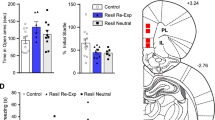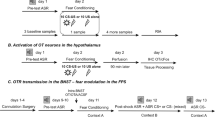Abstract
Rationale
Experiencing intrusive distressing memories of a traumatic event(s) is a prominent symptom profile for post-traumatic stress disorder (PTSD). Understanding the neurobiological mechanisms associated with this symptom profile can be invaluable for effective treatment for PTSD.
Objectives
Here, we investigated the functional role of the nucleus reuniens (RE), a midline thalamic in modulating stressor-related memory.
Methods
Female Long Evans rats were implanted with a cannula aimed at the RE. The RE was pharmacologically inactivated via muscimol (0.5 mM) prior to exposure to the predator odor stressor trimethylthiazoline (TMT; synthetically derived fox feces component) or water (controls) in a distinct context with bedding material (experiment 1) or no bedding (experiment 2). To measure context reactivity, the index of the contextual memory, 2 weeks following exposure to TMT, rats were re-exposed to the TMT-paired context (in the absence of TMT).
Results
In experiment 1, during context re-exposure (with bedding), inactivation of the RE had no effect on context reactivity. In experiment 2, during context re-exposure (no bedding), rats previously exposed to TMT showed decreased immobility compared to controls, indicating reactivity to the context and likely related to theincreased exploration of the environment. Rats in the TMT group that received RE inactivation showed increased immobility relative to rats that received aCSF, suggesting that muscimol pre-treatment blunted context reactivity.
Conclusion
In conclusion, recruitment of the RE in stressor-related contextual memory appears to be dependent on the contextual environment and whether the animal is able to engage in different stress coping strategies.





Similar content being viewed by others
References
Albrechet-Souza L, Gilpin NW (2019) The predator odor avoidance model of post-traumatic stress disorder in rats. Behav Pharmacol 30(2 and 3-Spec Issue):105–114. https://doi.org/10.1097/FBP.0000000000000460
APA (2013) Diagnostic and statistical manual of mental disorders (5th ed.). Washington, DC
Arakawa H (2007) Ontogeny of sex differences in defensive burying behavior in rats: effect of social isolation. Aggress Behav 33(1):38–47. https://doi.org/10.1002/ab.20165
Breslau N, Kessler RC, Chilcoat HD, Schultz LR, Davis GC, Andreski P (1998) Trauma and posttraumatic stress disorder in the community: the 1996 Detroit Area Survey of Trauma. Arch Gen Psychiatry 55(7):626–632. https://doi.org/10.1001/archpsyc.55.7.626
Cullinan WE, Herman JP, Battaglia DF, Akil H, Watson S (1995) Pattern and time course of immediate early gene expression in rat brain following acute stress. Neuroscience 64(2):477–505
De Boer SF, Koolhaas JM (2003) Defensive burying in rodents: ethology, neurobiology and psychopharmacology. Eur J Pharmacol 463(1–3):145–161. https://doi.org/10.1016/s0014-2999(03)01278-0
Eichenbaum H (2017) Prefrontal-hippocampal interactions in episodic memory. Nat Rev Neurosci 18(9):547–558. https://doi.org/10.1038/nrn.2017.74
Fitzpatrick CJ, Knox D, Liberzon I (2011) Inactivation of the prelimbic cortex enhances freezing induced by trimethylthiazoline, a component of fox feces. Behav Brain Res 221(1):320–323. https://doi.org/10.1016/j.bbr.2011.03.024
Fucich EA, Morilak DA (2018) Shock-probe defensive burying test to measure active versus passive coping style in response to an aversive stimulus in rats. Bio Protoc 8(17). https://doi.org/10.21769/BioProtoc.2998
Furtak SC, Wei SM, Agster KL, Burwell RD (2007) Functional neuroanatomy of the parahippocampal region in the rat: the perirhinal and postrhinal cortices. Hippocampus 17(9):709–722. https://doi.org/10.1002/hipo.20314
Hwa LS, Neira S, Pina MM, Pati D, Calloway R, Kash TL (2019) Predator odor increases avoidance and glutamatergic synaptic transmission in the prelimbic cortex via corticotropin-releasing factor receptor 1 signaling. Neuropsychopharmacology 44(4):766–775. https://doi.org/10.1038/s41386-018-0279-2
Jaramillo AA, Randall PA, Frisbee S, Besheer J (2016) Modulation of sensitivity to alcohol by cortical and thalamic brain regions. Eur J Neurosci 44(8):2569–2580. https://doi.org/10.1111/ejn.13374
Jayachandran M, Linley SB, Schlecht M, Mahler SV, Vertes RP, Allen TA (2019) Prefrontal pathways provide top-down control of memory for sequences of events. Cell Rep 28(3):640–654. https://doi.org/10.1016/j.celrep.2019.06.053 (e646)
Kafetzopoulos V, Kokras N, Sotiropoulos I, Oliveira JF, Leite-Almeida H, Vasalou A, Sardinha VM, Papadopoulou-Daifoti Z, Almeida OFX, Antoniou K, Sousa N, Dalla C (2018) The nucleus reuniens: a key node in the neurocircuitry of stress and depression. Mol Psychiatry 23(3):579–586. https://doi.org/10.1038/mp.2017.55
Kessler RC, Berglund P, Demler O, Jin R, Merikangas KR, Walters EE (2005) Lifetime prevalence and age-of-onset distributions of DSM-IV disorders in the National Comorbidity Survey Replication. Arch Gen Psychiatry 62(6):593–602. https://doi.org/10.1001/archpsyc.62.6.593
Kessler RC, Sonnega A, Bromet E, Hughes M, Nelson CB (1995) Posttraumatic stress disorder in the National Comorbidity Survey. Arch Gen Psychiatry 52(12):1048–1060. https://doi.org/10.1001/archpsyc.1995.03950240066012
Kilpatrick DG, Resnick HS, Milanak ME, Miller MW, Keyes KM, Friedman MJ (2013) National estimates of exposure to traumatic events and PTSD prevalence using DSM-IV and DSM-5 criteria. J Trauma Stress 26(5):537–547. https://doi.org/10.1002/jts.21848
Lin YJ, Chiou RJ, Chang CH (2020) The reuniens and rhomboid nuclei are required for acquisition of pavlovian trace fear conditioning in rats. eNeuro 7(3). https://doi.org/10.1523/ENEURO.0106-20.2020
Maisson DJ, Gemzik ZM, Griffin AL (2018) Optogenetic suppression of the nucleus reuniens selectively impairs encoding during spatial working memory. Neurobiol Learn Mem 155:78–85. https://doi.org/10.1016/j.nlm.2018.06.010
Mei H, Logothetis NK, Eschenko O (2018) The activity of thalamic nucleus reuniens is critical for memory retrieval, but not essential for the early phase of “off-line” consolidation. Learn Mem 25(3):129–137. https://doi.org/10.1101/lm.047134.117
Neal S, Kent M, Bardi M, Lambert KG (2018) Enriched environment exposure enhances social interactions and oxytocin responsiveness in male Long-Evans rats. Front Behav Neurosci 12:198. https://doi.org/10.3389/fnbeh.2018.00198
Ornelas LC, Tyler RE, Irukulapati P, Paladugu S, Besheer J (2020) Increased alcohol self-administration following exposure to the predator odor TMT in active coping female rats. Behav Brain Res 402:113068. https://doi.org/10.1016/j.bbr.2020.113068
Ramanathan KR, Jin J, Giustino TF, Payne MR, Maren S (2018a) Prefrontal projections to the thalamic nucleus reuniens mediate fear extinction. Nat Commun 9(1):4527. https://doi.org/10.1038/s41467-018-06970-z
Ramanathan KR, Maren S (2019) Nucleus reuniens mediates the extinction of contextual fear conditioning. Behav Brain Res 374:112114. https://doi.org/10.1016/j.bbr.2019.112114
Ramanathan KR, Ressler RL, Jin J, Maren S (2018b) Nucleus reuniens is required for encoding and retrieving precise, hippocampal-dependent contextual fear memories in rats. J Neurosci 38(46):9925–9933. https://doi.org/10.1523/JNEUROSCI.1429-18.2018
Randall PA, Lovelock DF, VanVoorhies K, Agan VE, Kash TL, Besheer J (2021) Low-dose alcohol: Interoceptive and molecular effects and the role of dentate gyrus in rats. Addict Biol 26(3):e12965. https://doi.org/10.1111/adb.12965
Riittinen ML, Lindroos F, Kimanen A, Pieninkeroinen E, Pieninkeroinen I, Sippola J, Veilahti J, Bergstrom M, Johansson G (1986) Impoverished rearing conditions increase stress-induced irritability in mice. Dev Psychobiol 19(2):105–111. https://doi.org/10.1002/dev.420190203
Rosen JB, Asok A, Chakraborty T (2015) The smell of fear: innate threat of 2,5-dihydro-2,4,5-trimethylthiazoline, a single molecule component of a predator odor. Front Neurosci 9:292. https://doi.org/10.3389/fnins.2015.00292
Schwendt M, Shallcross J, Hadad NA, Namba MD, Hiller H, Wu L, Krause EG, Knackstedt LA (2018) A novel rat model of comorbid PTSD and addiction reveals intersections between stress susceptibility and enhanced cocaine seeking with a role for mGlu5 receptors. Transl Psychiatry 8(1):209. https://doi.org/10.1038/s41398-018-0265-9
Shallcross J, Hamor P, Bechard AR, Romano M, Knackstedt L, Schwendt M (2019) The divergent effects of CDPPB and cannabidiol on fear extinction and anxiety in a predator scent stress model of PTSD in rats. Front Behav Neurosci 13:91. https://doi.org/10.3389/fnbeh.2019.00091
Silva BA, Burns AM, Graff J (2019) A cFos activation map of remote fear memory attenuation. Psychopharmacology 236(1):369–381. https://doi.org/10.1007/s00213-018-5000-y
Tyler RE, Weinberg BZS, Lovelock DF, Ornelas LC, Besheer J (2020) Exposure to the predator odor TMT induces early and late differential gene expression related to stress and excitatory synaptic function throughout the brain in male rats. Genes Brain Behav 19(8):e12684. https://doi.org/10.1111/gbb.12684
Weera MM, Schreiber AL, Avegno EM, Gilpin NW (2020) The role of central amygdala corticotropin-releasing factor in predator odor stress-induced avoidance behavior and escalated alcohol drinking in rats. Neuropharmacology 166:107979. https://doi.org/10.1016/j.neuropharm.2020.107979
Xu W, Sudhof TC (2013) A neural circuit for memory specificity and generalization. Science 339(6125):1290–1295. https://doi.org/10.1126/science.1229534
Yehuda R (2004) Risk and resilience in posttraumatic stress disorder. J Clin Psychiatry 65(Suppl 1):29–36
Acknowledgements
The authors thank Abigail Garcia-Baza for their help with behavioral analysis.
Funding
This work was supported in part by the National Institute of Health AA026537 and AA011605 (JB) and by the Bowles Center for Alcohol Studies. LCO was supported by Diversity Supplement to AA026537.
Author information
Authors and Affiliations
Corresponding author
Ethics declarations
Conflict of interest
The authors declare no competing interests.
Additional information
Publisher's Note
Springer Nature remains neutral with regard to jurisdictional claims in published maps and institutional affiliations.
Rights and permissions
About this article
Cite this article
Ornelas, L.C., Van Voorhies, K. & Besheer, J. The role of the nucleus reuniens in regulating contextual conditioning with the predator odor TMT in female rats. Psychopharmacology 238, 3411–3421 (2021). https://doi.org/10.1007/s00213-021-05957-x
Received:
Accepted:
Published:
Issue Date:
DOI: https://doi.org/10.1007/s00213-021-05957-x




